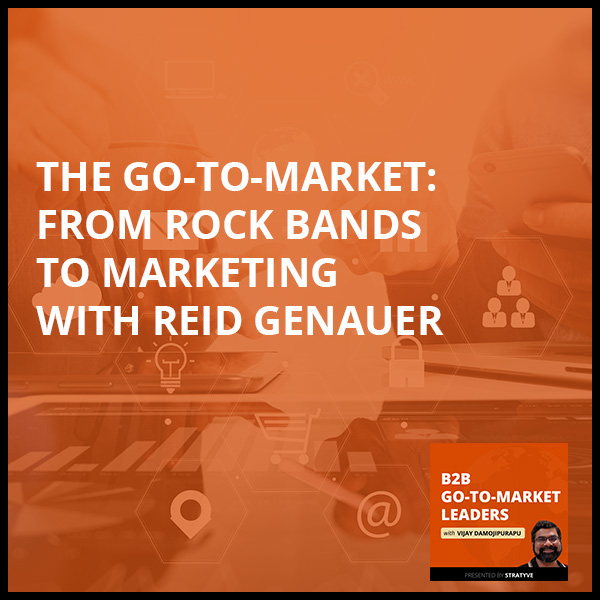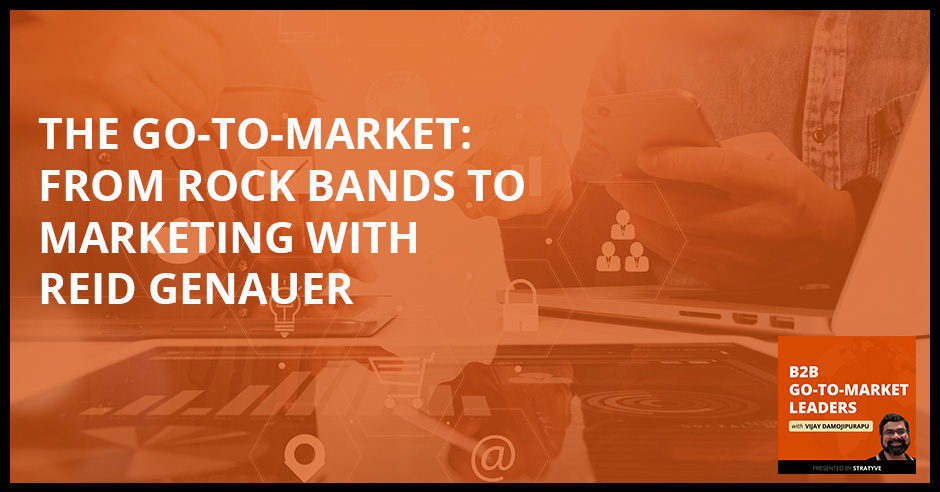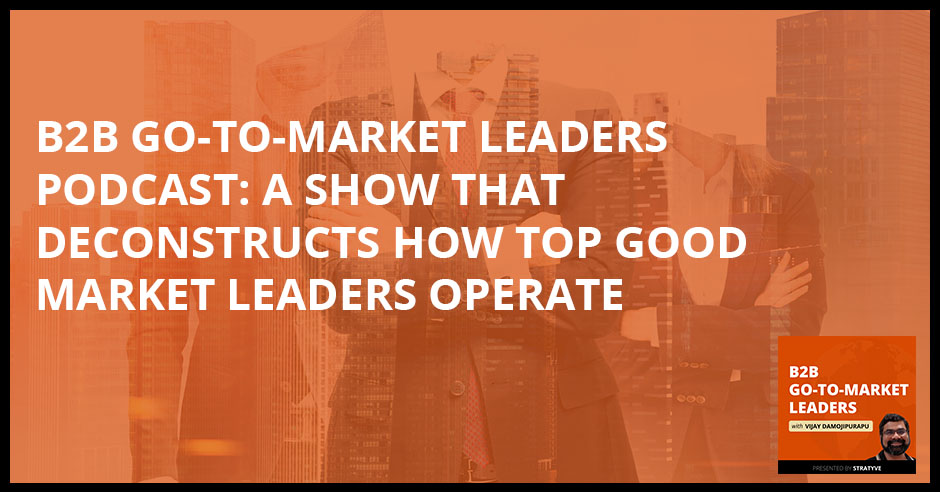

Many marketing leaders and entrepreneurs stumble into the space by sheer discovery. For Reid Genauer, that is from starting a rock band all by himself, which eventually led him to learn the vocabulary and skills to go and transition into the marketing world. In this episode, he joins host, Vijay Damojipurapu, to share with us that colorful and bright career journey and the lessons it taught him that shaped his thinking as a marketing leader. Notably, he dives deep into the go-to-market that companies need to utilize. Reid also answers some key questions that are often faced by many leaders in the industry. How do you manage that debate between product finance and marketing? What are your goals for the next six to twelve months, especially with the COVID-19 pandemic going on? All of this and more in this insightful conversation.
—
Listen to the podcast here
The Go-To-Market: From Rock Bands To Marketing With Reid Genauer
I’m super thrilled and excited to have Reid Genauer on the show. As a way of introduction, Reid has a very colorful and bright career that started off in a rock band or music band all by himself, and then transitioned into the marketing world. Reid, welcome.
Thank you. It’s great to be here. My friends and family would describe me as colorful as well.
You have a very distinct bio in the sense that you didn’t start off in the marketing career. You started off doing your own music and rock band, but something triggered you to get into marketing. Can you share your thoughts on what led you to this journey?
As a teenager, I had a passion for music. There was no question in my mind that’s what I was going to do. I was going to go out and play in a rock band. I started writing songs in the seventh grade. My future is like this question mark. If that canvas was painted black waiting for the color, it was like a point of light that I headed towards. There is a whole side story about my musical life that’s interesting in achieving and chasing that certainty. I was supporting myself and then at the age of 22, 24, there was ten of us full-time doing this as bottoms up, DYI, which is the norm these days. This was in late ‘90s. We were a little ahead of the curve. I wouldn’t have called it this then, but looking back we needed strategy, positioning, infrastructure and go-to market.
What was fascinating is we bootstrapped it and learned these things as we went. After nearly ten years of doing that, I went to business school. I was like, “That was called strategy, positioning, product-market fit, go-to market in the forms of direct mail, newsletters and such promotion, etc.” We recorded our own records, produced them, distributed them ourselves. We were vertically integrated. It was a very painful transition for me personally, but in regards to my personal and professional growth, it was transformative in that I had all this raw material and all this real-life experience. All of a sudden, I had the context, the vocabulary and the skillset to not only describe it but replicate it in another setting.
I don’t think of myself as a marketer. I think of myself as an entrepreneur. That go-to market happens to be the piece of the puzzle that I was trying to impart. I have to be honest coming from this life as a songwriter and an entrepreneur. At the time, I did brand marketing, private equity/finance or consulting. Part of the reason I don’t want to be in a band anymore is I played in 48 out of 50 states. I’ve been in transit for the last several years.
For the benefit of the audience, are you talking about your time at Cornell Johnson School while you’re doing your MBA and you’re trying to figure out what next?
Yeah. I was evaluating the three main rounds. Consulting for me was a deal killer that you had to be gone all the time. I wish I knew more about venture capitalism and private equity. What it comes down to was my dad was a commercial banker. He wore a gray suit every day. I was like, “No, check that one off.” I felt closest to the creative process. There’s the behavioral science part of marketing, which is interesting. It’s like being an anthropologist. That was how I landed on that channel. Ultimately, I wanted to get to where I am, be part of a leadership team, and guiding the direction of an organization.
This is something that I’ve seen especially with the various product or even marketing leaders and even entrepreneurs. It’s all about the opportunity or what they need to do to get to the next stage. In your case, when you are trying to build up the rock band and trying to increase awareness, bring the audience, create publicity and get to the channel or the customer segment, you need to figure out all the various pieces, which you refer to as the positioning, the messaging, the marketing strategy, the various channels and so on. I see a single thread running across even with the various entrepreneurs, which is “I’ve got this cool product, but is this product serving the customer segment?” Even if I step back, who is the customer segment? What is the pain point? It’s a constant circle of questions, insights and hypothesis, which leads you to a natural good market state of thinking.
I have two responses to that. One is that tends to be the way that I approach assessing a company, whether or not I want to be a part of it or if I want to create it. Where I extend my energy and where I need to focus as part of the executive team is to look at what the critical path is like, what’s the blocker here? That’s an interesting way because many times throughout a company’s growth, you hit a roadblock. It’s understanding what that roadblock is and what the “medicine” is for that particular pain point. It might be across any one of those. It’s not always in historic marketing definition.
That’s why I like to use the term go-to market because it could be somewhere else in the company’s DNA. What you said is important to focus on. I came to these two roles ago at Magisto, which is an automated video editor. It’s the notion of product-market fit. Part of what drew me to marketing is the behavioral science part, the anthropological part. It’s not a criticism. It’s an observation even of myself. I think there’s an abundance of technology in Silicon Valley and technologists. There’s an abundance of good ideas. There simply is not enough focus on product-market fit and on what that means, that it’s not a destination, it’s a journey.
An overt example of that is oftentimes companies are going, “Why aren’t we growing?” In effect, they’ve met the edge of their addressable market and they have to expand. You have to go through a very aggressive product-market fit cycle. There are other more nuanced ways. I spent a lot of time in video. If you look at all the video applications out there, many of them deliver the same basic gain or solve the same basic problem, which is I need to create a go-to market video. Little things like how you described the benefits, the UI and getting at those features can make all the difference. That’s a nuanced part of product-market fit. It’s like, “Do I have to become a video editor or is it very intuitive on how to kick something out that’s high quality?” If you listen to the customer in almost anything you do and it’s just not enough. Tony Hsieh is like the Dalai Lama of customer-centric go-to market. I aspire to be as one with it as he is. That’s what it comes down to.
It’s all about listening and empathy.
Related to that, the other observation I have is that in the absence of valuing that, holding that as sacred, because everyone says it’s one thing to say it. It’s a spectrum, but it’s another thing to do it as a core competency, as an organization. If you don’t, what you tend to wind up doing is burning valuable cycles on product iteration that may or may not be going down the right path. There’s a bunch of reasons that it happens. It’s somebody’s personal pet project. You’re looking at what competitors do. Sometimes it’s not an apples to apples fit. You do it because they did it, but for your business, it’s not right. I’ve been guilty of this before, sometimes by my own motive and sometimes because there’s pressure to do it. Driving more traffic to a product that doesn’t have fit is like putting a band that stinks in front of a huge audience. It doesn’t matter how big the audience is if the music isn’t any good. It’s a lot of that where it’s like more traffic, better traffic. If the drummer can’t keep it timed, you can put a bigger audience as you want and the lead singer is up, it’s not going to work.
Notionally and in principle, leaders across the company, the C-Suite or even one level below get that. You hit upon a very important point, which is due to the various pressures either from the top leadership or from the board or from the investors, there’s this pressure of, “We don’t care, you need to deliver results.” There’s the irony and circular dependency of in order for you to deliver the results, you need to understand the market. It’s like, “It doesn’t matter. Keep pumping money and deliver the results or drive traffic.” At what point in time would you step up as a leader? I’ve seen that personally. I’ve struggled at various times. I’ve seen others struggle as well.
That’s a complex question because the other reality, it’s easy to sit and pontificate about this stuff generally. It’s harder when you’re in the tag of war. We all make the same mistakes over and over. It’s like a trip around the sun. You learn something each time. For me, either if it’s in a new role or if I’m at a company that you can feel and seeing the numbers is plateauing, that’s often when the realization hits me and I need to take a step back and look at the bigger problem or the bigger opportunity, and why we’re not capturing. We go through an audit almost of how we’re structured, what we’re offering, and what the market trends are.
There are three stools, the company itself, your current, future and past customers in some cases, and the market itself. You should be doing it in a very awake fashion all the time. You get sucked into execution and it’s unavoidable because as a startup, you have to live to fight another day. It’s the George Washington thing. Sometimes you have to compromise on doing things that are short-term and inherently flawed to keep the patient healthy enough to get to the emergency rooms.
As a startup, you have to live to fight another day. Share on X
Looking back at your journey, after the MBA, you started in brand marketing at Snapple, and then you grew in the ranks. You moved a bit into the consumer and the B2B space. What would you say are the real inflection points or how did that journey shape your thinking as a marketing leader?
Once I made the decision to stop doing music full-time, I was doing a product-market fit evaluation on myself. I realized that part of it was rational and part of it was gut that I wanted to be at the intersection of technology and media. I wanted to be an entrepreneur because all of those things have creative components. I tended to work at companies that deal with mass creativity, eMusic which is independent music, Fox Mobile where I launched over the top television, and Magisto which is social singing.

There’s been the literal creative and then there’s the broader definition of creative. Auto mechanics and accountants can be creative in how they approach their jobs. Company building and entrepreneurship is a creative exercise metaphorically and literally. You’re building a company. It’s like building a tree fort. I always loved doing it, but what do you do once the tree fort is built? You sit in it for a day and then you go and build the next one. Larger companies for me were never attractive. It’s equivalent to sitting in the tree fort or making slight improvements to it.
I knew this is where I wanted to be. The tech industry has changed so much since I went to business school in 2000. There was no Google. There was no on-campus recruiting. I had a job offer from Unilever. I chose Snapple over Unilever because it was less traditional and a better fit for me. I looked at it as part of almost like finishing school for my MBA. It’s what you do and I’m glad I did. First of all, even though I took data-driven marketing and entrepreneurship at school, it’s focused on brand management. I went and put the skills that I learned to use.
I acquired other ones. I took that into the tech world. It’s been an interesting journey. The first company I went to work for was eMusic. I knew them because I had been distributed by them when digital music first hit. I forget what the other one was. It’s like Audio Lunchbox or something. There were two of them. I was like, “This is an interesting company. This space is going to grow.” When I went there, digital music was like 6% of the market. I don’t know what the stat was then, but it’s the bulk of them. It was fascinating. What was very clear early on were two things. One was, there was no role for me long-term and no career path without doing data-driven marketing, growth marketing.
That’s where I got my ninja skills for that component of go-to market. I’d say there were three big takeaways. Two is that those companies need strategy positioning and branding like any other company. At the time, they didn’t realize it. Interestingly, they are leading the way in terms of how you deliver that to the consumer because of the digital disruption. When I started working at eMusic, the word brand was almost a four-letter word. I was like, “Don’t even utter it in my presence.” It’s because people didn’t understand what it was.
You turn around and X-teen years later, they’re the ones that are defining it. A lot of consumer-packaged goods and physical products are looking to digitally native companies to understand how to articulate a brand, and how to position a company in a digital world. It’s a different exercise. The last thing I was going to say is that the power dynamic is very different. As a brand manager, you are a GM more or less. You’re a little king in a way. If you could have seen me two years, I’m not sure you would have given me this responsibility.
First of all, the technology, not that they’re holding anybody ransom, it’s just the nature of these businesses. The technologists are the power center. If the band can’t play, then there’s only so much the marketer can do. They tend to have more of the resources depending on the business. If you have a product that has any technological sophistication, you’re going to have more of the employees there. The ways that the functional departments interact is distinctly different than traditional companies. It’s better and leading the way. It’s still flawed within tech companies, but it’s much more integrated than traditional.
You hit up on a couple of key points, one which is very relevant to the audience and to this show is the balance between product, which you refer to as a technologist, and the data that the marketing team, be it brand or product marketing, or even other like data-driven marketing operations. That data which they had to bring to the table and justify budget are investments. This is a constant challenge. I’ve seen that play out at the C-Suite level as well. Do we allocate more budget and resources to engineering, which is incremental or new features, versus dedicate X amount of dollars for investing in a new brand? If not a new brand, what are the campaigns that we need to run? This is a constant struggle. How do you manage that debate that goes on in the C-Suite between product finance and then marketing?
I’d go back to my original answer. It’s imperfect because there are things like personal ego. I’ll talk to some of the forces that often drive us to make the wrong decisions on that front. The core for me is looking at critical path. Let’s say a company is more mature and the basic infrastructure, because the pace of innovation is so rapid, Moore’s Law, it may be that you have such institutional debt in your infrastructure. That’s your critical path. You can’t do the things you know you should do because the code base is either so old or Millennium Falcon-like. In that case, as a marketer, you have to do this balancing act.
I would argue to give up some of my marketing budget to fix that so that we can then take a step back so we can move forward. If we take an honest assessment of saying the onboarding experience, we look at the numbers and we say, “We’re driving tons of traffic.” They seem to be qualified and they’re falling off at this point, then I would argue for a product. If it’s something stupid like the onboarding process and the UI is confusing, I would argue for that. If we have this amazing band that’s been practicing for ten years in the basement has invented a new style of music, the world loves it and it’s just a matter of bringing it to them, then I would fight for more budget on my side.
It’s never that binary because you have to live to fight another day. You tend to focus on your needs and wants as a department head. If it’s truly a technology company and/or product company, the core activity of what you do is invent. Oftentimes, I’m tempted to say an injustice because it sometimes feels that way with me, but it’s not an injustice. It’s a bias. There’s a second reason for this. One is this is what we do. We don’t have to justify the budget. We’re in the business of inventing things so we have to fund that.
When you have to live to fight another day, you tend to focus on your needs and wants as a department head. Share on X
The second is true customer or product-market fit is very inter-departmental. It can be fed by mid-level employees, but it has to be driven from the top. It’s uncomfortable. You have to be able to distill all different forms of the quantitative and qualitative information. You need to toggle between TED-like 100,000-foot observations and ground level observations to find it. Either the leadership doesn’t have the time to do it because they’re running the company or they don’t like it because it’s not as binary as some of the other functions.
Lastly, advertising is the most binary at least in the short-term. You spend a dollar and you see the return. What you don’t see is the lifetime value. That is hidden in the product-market fit. It’s hidden in the product execution. It’s hidden in the institutional debt. It’s much harder to read. It’s why we tend to focus on the head of the funnel. In general, my thesis is listen to the customer and focus on the end of the funnel first. What are you truly selling before you dump? It’s not a way of getting out of my job. I look at that as part of my job, as part of our go-to market to say, “We can go out and start spending money, but what are we selling it to who? What is the core value?” It’s often not even in what you’re selling.
Tony Hsieh is a genius. He’s selling happiness. The product happens to be shoes. Most companies are like that. There are some exceptions. Network routing, I’m not sure you would argue. You could say you’re selling stability, but there’s an emotional benefit to most products, B2B and B2C. You have to start with and then say, “What’s the functional benefit after that?” There’s a path to market that starts with, what’s the core of what we’re selling? Do we understand that? Oftentimes when you unpack it, you don’t or the company doesn’t. Maybe 2 out of 5, or 5 out of 5 of the leadership team does, but there isn’t good middleware to communicating that to the rest of the company. They’re not sure why they’re executing every day. They just come in and march.
You touched upon several points in what you covered. One point I’d like us to deep dive into further is the challenge area that you mentioned, which is the go-to market is not owned by one single function. It’s a cross-functional initiative. Most often what happens is the mid-level people would see it like a director of product or sales, or even director of customer sales and marketing would see that. Their views and effort or impact that they can make is very siloed within that one function. It has to boil up to the C-Suite, the top-level leadership, who has a broader view or come from it.
In early-stage companies, it does by definition. As the company grows, it gets harder for the leadership to do it and/or they never loved doing it in the first place.
Everything in motion, it happens. The go-to market motion continues to go on. As long as the results are delivered, it’s not a pain point.
When you hit some plateau or snafu, you start to ask the question of, what is it here? Is it we’re not bringing in enough people or we don’t qualify the leads well enough? The value proposition isn’t strong enough. The pricing structure is wrong. There are all questions you start to ask. It’s a nuanced, but powerfully different answer depending at what stage company you’re in. The question is still the same which is, what is our process for gathering that information, distilling it and executing against it? I don’t think there’s one single answer, but here’s something that I propose. If the leadership team agrees at something critical ideally in the ongoing DNA either in the inception of a company or an inflection point, which is a generous crisis, what’s the process for doing this?
I also think it’s a lot to ask of middle management to do on their own because it takes some pattern recognition or helps to have it, and it’s not so much the seniority as the way the individual’s mind works. What product-market fit is you have to be able to watch seventeen televisions or more like read five articles, watch seven televisions, listen to nine podcasts and talk to 100 people at once. That takes a certain type of brain to be able to find the signal to noise in that. What I would recommend for any company is that there’s a pyramid where there’s an agreement on these are the things we need to know and these are the ways we’re going to gather the information. That information gets packaged and sent to a central owner and even the content itself in a central repository so it all lives in one place.
There can be a hypothesis and observations presented to either senior leadership or presented by senior leadership to a CEO. At some point though, the senior leadership and the CEO has to get their hands dirty at not only in synthesizing the end outcome but listening to at least one radio station, watching 1 or 2 television shows so that you have your own sense of the market and your own touch by which to assess the larger data sets that come in. If you don’t, it lacks context. Not that I’m genius about it or anything, but I’ll see something different than somebody else will.

There are a couple of thoughts running in my head. One is someone like a GM or a COO, depending on the stage of the company and size of the company. There’s someone central who is viewing all these seventeen television channels, who is reading all these magazines, listening to the podcast and then synthesize it, boiling it down to 3 or 5 insights. Who is that one person and how often does it need to happen?
The hard truth is the CEO should be running it. It depends where many tech companies are challenged that the CEO is not doing the job they should be doing, which is being a CEO. They’re still busy being head of a product or technology. If the company is mature enough that the COO and the various department heads, or if the CEO is being a CEO, he or she should be able to do that, raise money, have a vision, understand the market, translate that vision of the company and hire the right people. That’s your job.
For some reason, we cannot generally say all these things, but will you say that this is an opportunity for an outside person or a consultant to bring in and build that muscle? It’s more of reminding or bringing in that outside perspective for the CEO to make the decision.
I was starting by pointing out what should be, but what you’re saying is that’s not probably the reality and I tend to agree with you. My bias is not to lean on a consultant to do that because it has to be part of the company DNA. Maybe to get you oriented and help you jumpstart, maybe as one of those voices. My experience is a consultant can’t come in and do that work for you because they’re not part of the company. They can come in and maybe hold up some blind spots that you have or be one of those many sources of information.
The 1 or 2 times that I’ve been most successful at it, there have been consultants who have lent various positioning like broad generalists who deliver information, focus groups or survey companies, third-party data, consultants who come in and work with you to sort through it all. There are roles for consultants. To put that in a consultant’s hands would be blasphemy in my opinion. That would be like handing the car over to my fourteen-year-old to drive. That’s not responsible. The short answer is the CEO has to be involved, to what degree is questionable, and in the absence of that, it can be a CMO, a head of product, a chief strategy officer, these relatively new CXO or Chief Experience Officer. That one strikes me as the most obvious CMO or CXO working in tandem with product. That’s how I think of that.
As we move more towards closing, I’ve got last few questions for you. One is what are your big goals for the next 6, 12 months? How are you going about prioritizing from a go-to market perspective? If you had an extra budget, which area or where would you invest your resources, either in key hires or bringing in external experts?
I know the nature of this question is more tactical, but I’m going to answer it with what I call a Bill Clinton answer, a politician’s answer. It’s partly what interests me most right now is that even prior to COVID, there’s a disruption that’s going on globally in more than marketing. What sums it up for me is the medium is the message. Any of us in marketing and media refer to that phrase. I went back and read it because I wasn’t 100% sure I understood it. The notion is that media messages and stories are an extension. It’s an ecosystem and an extension of the human nervous system and human psychology, sociology and market.
The medium is the message. Share on X
It’s deep observations that came from this guy before things like the internet even existed. His point is that there are two ecosystems. One is the nature of the message and the medium. My message might be talking about customer development. If I were to deliver that in a written, scripted pen and quill message on parchment paper, that would be different. It would affect you differently receiving it than if I typed it on a typewriter, than if I telegraphed it to you or if I called you on the phone or if we did a video. The nature of the medium affects the message, the richness of it and the quality of it. With 50% of the world not just on digital but also on social, it means we are connected to each other in a way we never have been.
The medium is social and it is video. It’s not to say there aren’t others, but that’s the central one of our time. The message is the individual new narrative. It’s me. Look at what we spent an hour doing, telling you my individual narratives. That is inherently different than the history of humankind, which has been top down narrative. Here’s the story, consume it. To the extent that you want to debate it, you do it as water cooler chatter that’s perishable. It’s not a body of media. Nowadays, it’s the largest body of media and it’s the largest dataset in the world, personal opinion. When you think about go-to market, you have to think about that. I would call it a crisis for anyone who needs to deliver a message to a large group of people. That’s one.
The perception is that there is not a Unilever, and to some degree there isn’t a Unilever playbook exactly. There is a tool chest. Where it’s interesting as it’s being defined from the bottom up. It’s native digital companies and it’s companies run by Millennials that understand how to do this. It has to be synthesized and adapt it for larger organizations. That’s one. Two, part of that playbook is redefining how we conceptualize knowledge. When I was a kid and you wanted to learn about George Washington from home, you opened the Encyclopedia Britannica and there were four paragraphs, and that was knowledge.
Now there are new findings and new information being added at such a staggering rate that part of the playbook for any go-to market, any company has to be that learning is the new knowing. There are certain static things that we can depend on. Here’s how we deliver brand. First of all, let’s make sure a company understands what the difference between corporate ideas and branding. There are still concrete truths. A large part of it, the tip of the sphere has to be learning what is now and adjusting.
This applies to both the B2B as well as the consumer companies.
I would say as much because companies for the first time in history are competing with consumers for attention. Let’s say you’re a CTO looking for a CRM solution. You’re the CRM provider. You think of all the information that’s bombarding the CTO both directly business related and otherwise. You’re fighting all of that noise to land your signals. How do you do it?
You raised a very important point. People tend to forget that even though you’re doing a B2B marketing and sales program, at the end of the day, the receiving indigent is the customer.
We talk about LTV, retention and users. We should use the word people more and consider them. At some level, there’s still this hangover from the industrial revolution where go-to market was advertising. It’s not. Marketing is more of a sales cycle than it is an advertising exercise.
Marketing is more of a sales cycle than it is an advertising exercise. Share on X
Have you heard of this book Scientific Advertising?
No. Do you recommend it?
Absolutely. This was written way back in 1920s and I was reading it. It says the exact same principles that we as go-to market organizations try to implement as best practices. It’s 100 years old. It’s the same repeat. They’re still trying to do the same thing.
It’s the same with McLuhan. He said, “The medium is the message.” That was 1917 or something. It’s still relevant now. I appreciate that.

One final question, any shout out to 2 or 3 go-to market leaders who you see or you look up to as role models or peers that you use them as a sounding board or speak with them?
I don’t know Tony Hsieh well. I’ve met him once or twice but I look up to him. He understands this and the reason I call him the Dalai Lama is because you have to be able to hold some of this woo-woo looser ideology to execute the tactical part. He does. The guy is selling happiness. He’s convicted and he’s succeeding. He’s a great example. Another one is the guy who started SaaStr, Jason Lemkin. He wrote a blog post on how he goes to market. It’s fascinating to read because in it he says, “I honestly can’t tell you what works, but I can tell you what I do.” What’s so interesting is he does what I was pointing to. It’s all bottoms up and it’s almost all him. He goes and participates as an individual in the attention economy, within the tribe that he is speaking to. He’s built a healthy business and the largest community of SaaS-based B2B organizations on the planet by doing exactly what I was describing. That’s how it translates. I got inspired myself by answering that question. It’s a great read if you can find that blog post.
Thank you so much, Reid. It’s a wonderful conversation. You shared a lot of insights into how companies, individuals and leaders should think of a go-to market. As a wrap-up note, if someone wants to reach out to you or learn more about you, where can they find you?
It’s at Reid@ReidGenauer.com or LinkedIn is another decent one. It’s like my fifth inbox of the day to check. I’d start with my email.
Thank you once again. As always, you showed practical insights and thought leadership material for people to think about and up-level their go-to market. Thank you.
Important Links
- Reid Genauer
- Scientific Advertising
- Reid@ReidGenauer.com
- LinkedIn – Reid Genauer
About Reid Genauer
 Entrepreneur, Leader & Chief Marketing Officer (CMO) with deep experience in product market fit, data-driven growth, branding. Proven track record of scaling early-stage tech companies. Industry thought leader for mobile, social, video, music & media.
Entrepreneur, Leader & Chief Marketing Officer (CMO) with deep experience in product market fit, data-driven growth, branding. Proven track record of scaling early-stage tech companies. Industry thought leader for mobile, social, video, music & media.
I’m a new bread of marketing executive and support a new definition of marketing that spans disciplines and cross-functional teams. One that marries the power of story with data-driven insights and agile product development. Consumer sentiment is no longer perishable water cooler talk but rather the largest living body of media the world has ever known. Digital culture is defined by a nuanced set of social norms, unfathomable velocity, and oceans of information. My “superpower” is finding the signal amidst the white noise of the Attention Economy and translating that into product-market fit, corporate strategy and high impact execution. I’ve successfully launched and scaled B2C and B2B products by leading with customer needs, hearing their voice and answering it.
LEADERSHIP STYLE:
I’m energized by leading diverse personalities, interdisciplinary teams and inspired digital businesses. I help my teams succeed by fueling a culture of curiosity, passion, and possibility. With a high degree of emotional IQ and interpersonal trust, I help my teams deliver focused strategy, decisive tactical execution, honest analysis and iterative scale. I live at the cross-section of data, technology, and imagination. I love what I do.
COMBINING CRITICAL THINKING AND IMAGINATION:
I value decisive decision-making informed by a combination of analytics and conviction. The entrepreneurial sense of possibility inspires my belief in vision and imagination as a driver of value creation. Business intelligence, data analytics, and insights supports that belief and informs my actions.
MARKETING EXPERTISE:
(B2C, SMB, B2B2C)
-Scaling Start-Ups
-Product Market Fit
-Branding/Positioning
-Go-To-Market
-Customer Acquisition, Retention, and Revenue
-Product Marketing and CRM
-Business Development, Partnerships, and Sales Enablement
-Analytics & Customer Research
-Earned, Owned and Paid Media at Scale
-Paid Media
-Media Relations,
-Content Marketing
-Social Marketing
-SEO/ASO
Love the show? Subscribe, rate, review, and share! http://stratyve.com/



